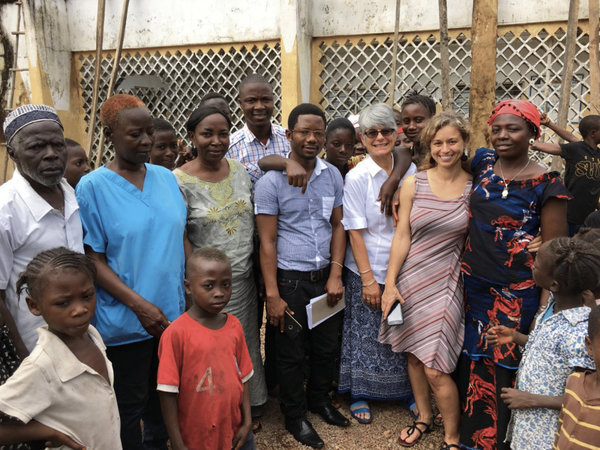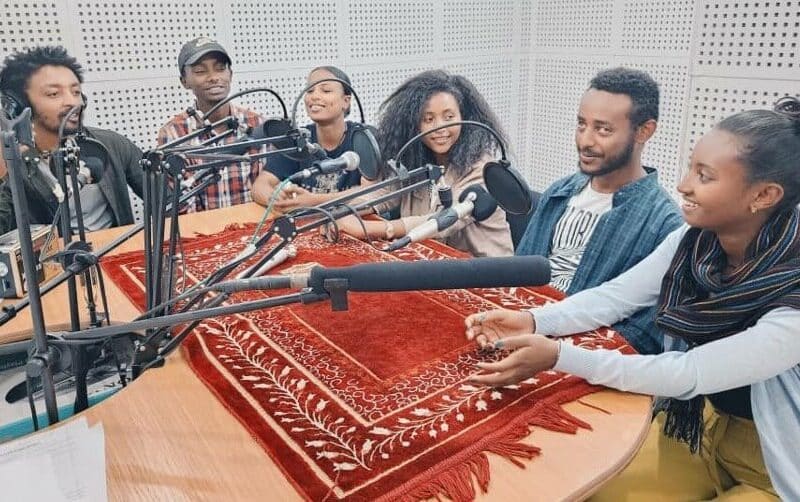Jane Brown grew up in Queens, the daughter of an accountant and teacher. Neither parent suggested that Brown follow in their footsteps, but her mother, civic-minded and active in the women’s rights movement, inspired her. Brown was too young to participate in the movement or the Vietnam protests, but social change entered her bloodstream along with an abiding belief that women everywhere deserved to be treated as equals to men.
Today, Brown is a senior program manager at the Johns Hopkins Center for Communication Programs (CCP) and an advocate for thinking about and addressing the way that disease spreads, biologically and socially, especially when it comes to HIV among women. She does this by supporting CCP teams in-country, helping communities determine their own solutions for addressing topics like maternal health, reproductive health and access to girls’ education.
“Jane is one of the most fearless advocates for women and gender and ensuring that people have – especially from an HIV perspective – the chance to live a full life,” says Rupali Limaye, PhD, a public health researcher at the Johns Hopkins Bloomberg School of Public Health who has worked with Brown for years.
Limaye and Brown worked together in the southeastern African nation of Malawi. When they first started working there, programs working on gender equality weren’t getting much attention. Social norms dictated not only what women could wear but what jobs they could do and most every other part of their lives. It often kept women from taking action to protect their health, such as going for HIV testing or for prenatal care. The BRIDGE program used communication approaches to engender dialogue around the impact of gender norms for women and men. “Thinking about the norms around HIV and AIDS, which very much includes gender, I think was a huge change for the country,” Limaye says.
With a salt-and-pepper pixie cut, Brown is unassuming and laid back. “Oh, hey,” she says when greeting friends and colleagues around CCP. In her office, opposite a standing desk, is a large poster of a plus-size Barbie doll laying on a couch. There are 3 billion women who don’t look like supermodels and only 8 who do, reads the caption. The bookshelves and tables are stuffed with odds and ends from her 20 years at CCP.
As an undergraduate at Clark University in Massachusetts, Brown gravitated to the community radio station, WCUW. After working in Europe after graduation, she returned to the United States, gained skills in video production and tried the corporate sector, developing promotional films for commercial products. It paid well enough to live in New York but didn’t fit with Brown’s passion for making a difference.
Brown decided to take some classes and, while researching a paper on health education, she came across a movie called It’s Not Easy (1990): one of the first AIDS drama produced in Africa. It’s Not Easy was produced by Media for Development Trust with support from CCP and others and funded by the United States Agency for International Development. It followed Suna, a new father in Uganda who learns that both he and his son are HIV positive and faces decisions about whether and how to disclose his status to his family and colleagues. Impressed with this film, Brown enrolled in the Master of Health Science program at what is now the Johns Hopkins Bloomberg School of Public Health, where she was inspired by passionate professors and the aspects of the curriculum that focused on communication and social change.
In 1994, as part of her course work, Brown evaluated a video from Zimbabwe called More Time. More Time was made to shatter taboos that prevented young people from talking about HIV and seeking advice from their parents. The title references the message of exposing young couples, especially women, to the advantages of postponing sexual activity and to encourage them to ask for more time. After a suitor presses her for sex, the main character, Thandi, decides to abstain.
In her evaluation of More Time, Brown found that the film had a positive effect on student viewers’ intent to talk candidly with their parents about sex, sexually transmitted infections and pregnancy. Brown’s interest in embedding health messages in movies, television, and radio shows grew.
After completing the evaluation of More Time, Brown joined CCP as a full-time employee. She then learned about a project focused on the Near East, started in 1999, called Arab Women Speak Out, created by several members of CCP’s staff. This work focused on promoting women’s empowerment and active participation in social development in Egypt, Lebanon, Tunisia and Yemen. It sought to address the popular perception of women in the Arab world as submissive to men. According to the project report that Underwood co-authored, “such images of disempowerment are inaccurate and self-perpetuating.” These representations are not only wrong, the report explained, they overlook the contributions that Arab women have made to improving society and the status of women in general.
Based on the success of Arab Women Speak Out, the creators sought to expand the approach to other regions of the world. Brown and Underwood and others spent several years designing, testing and adapting the approach. The project, called African Transformation, focused on creating an environment conducive to changing attitudes toward gender equality that was eventually used in nine African countries and involved both women and men. It is based on participatory development approaches inspired by the work of Brazilian educator Paulo Freire.
Freire argued that the best way to lift people out of poverty is to give them a voice. “It’s about developing critical consciousness,” says another of Brown’s colleagues at CCP, Carol Underwood, PhD. “It’s not about us telling people what gender norms are helpful or harmful but to help them come up with their own understanding and judgements.”
Brown led the adaptation of a facilitators guide, the production of videos and roll out of the initial pilot program, while Underwood led the evaluation to gauge its effect and impact. To Brown, the process validated the theories of social learning and empowerment education. “The methodology of creating a tool and space for people to explore gender norms and to see via film similar people who have overcome gender-related barriers is incredibly powerful,” she says.
Research that Underwood led which focused on African Transformation showed participants who took part in the project in Uganda were more likely to eliminate harmful traditional practices, such as intimate partner violence, than those who did not (34.5 percent compared to 19.1 percent).
Today, as a member of the CCP leadership team and the deputy director of Breakthrough ACTION, USAID’s flagship social and behavior change project, Brown continues to champion for inclusion of gender perspective in all of the center’s programming.
“Gender norms – positive or negative – impact all aspects of our lives,” she says. “We have an obligation to ensure women and men are better able to understand how these dynamics influence their decisions and how they can work together to foster greater gender equity in their homes and communities.”





